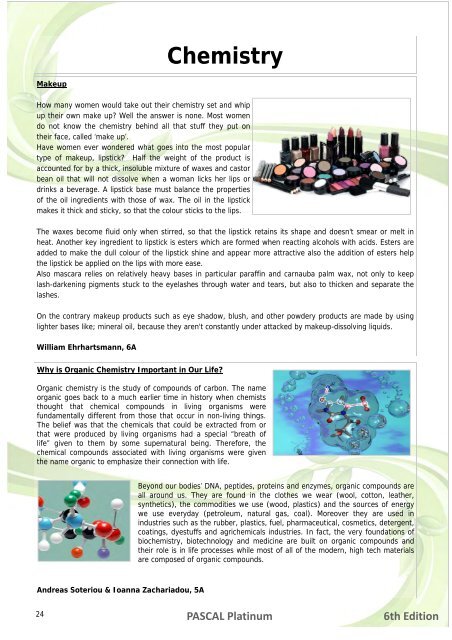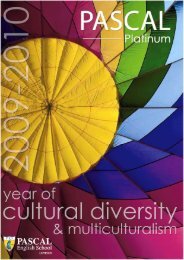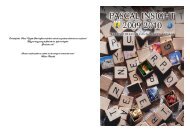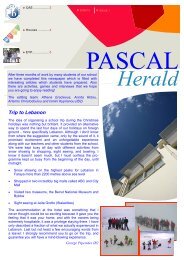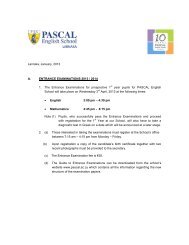ChemistryMakeupHow many women would take out their chemistry set and whipup their own make up? Well the answer is none. Most womendo not know the chemistry behind all that stuff they put ontheir face, called ‘make up’.Have women ever wondered what goes into the most populartype of makeup, lipstick? Half the weight of the product isaccounted for by a thick, insoluble mixture of waxes and castorbean oil that will not dissolve when a woman licks her lips ordrinks a beverage. A lipstick base must balance the propertiesof the oil ingredients with those of wax. The oil in the lipstickmakes it thick and sticky, so that the colour sticks to the lips.The waxes become fluid only when stirred, so that the lipstick retains its shape and doesn't smear or melt inheat. Another key ingredient to lipstick is esters which are formed when reacting alcohols with acids. Esters areadded to make the dull colour of the lipstick shine and appear more attractive also the addition of esters helpthe lipstick be applied on the lips with more ease.Also mascara relies on relatively heavy bases in particular paraffin and carnauba palm wax, not only to keeplash-darkening pigments stuck to the eyelashes through water and tears, but also to thicken and separate thelashes.On the contrary makeup products such as eye shadow, blush, and other powdery products are made by usinglighter bases like; mineral oil, because they aren't constantly under attacked by makeup-dissolving liquids.William Ehrhartsmann, 6AWhy is Organic Chemistry Important in Our Life?Organic chemistry is the study of compounds of carbon. The nameorganic goes back to a much earlier time in history when chemiststhought that chemical compounds in living organisms werefundamentally different from those that occur in non-living things.The belief was that the chemicals that could be extracted from orthat were produced by living organisms had a special “breath oflife” given to them by some supernatural being. Therefore, thechemical compounds associated with living organisms were giventhe name organic to emphasize their connection with life.Beyond our bodies’ DNA, peptides, proteins and enzymes, organic compounds areall around us. They are found in the clothes we wear (wool, cotton, leather,synthetics), the commodities we use (wood, plastics) and the sources of energywe use everyday (petroleum, natural gas, coal). Moreover they are used inindustries such as the rubber, plastics, fuel, pharmaceutical, cosmetics, detergent,coatings, dyestuffs and agrichemicals industries. In fact, the very foundations ofbiochemistry, biotechnology and medicine are built on organic compounds andtheir role is in life processes while most of all of the modern, high tech materialsare composed of organic compounds.Andreas Soteriou & Ioanna Zachariadou, 5A24<strong>PASCAL</strong> <strong>Platinum</strong><strong>6th</strong> <strong>Edition</strong>
BiologyEscherichia Coli (E. Coli) 0157: H7What is Escherichia coli (E. coli) 0157:H7 infection? : E. Coli are bacteria that normallylive in the intestines of humans and animals. Although most strains of this bacteria areharmless, several are known to produce toxins that can cause diarrhea. One particular E. colistrain called 0157:H7 can cause severe diarrhea and kidney damage.Who gets E. coli 0157:H7 infection? : Anyone of any age can become infected with E. coli0157:H7, but children and the elderly are more likely to develop serious complications.How does one get infected with E. coli 0157:H7? : The bacteria are acquired by eatingfood containing the bacteria. The bacteria live in the intestines of some healthy cattle, and contamination of themeat may occur in the slaughtering process. Eating meat that is rare or inadequately cooked is the most commonway of getting the infection. Infection can also occur after consuming foods such as lettuce, alfalfa sprouts,salami, and unpasteurized milk, juice or cider. Person-to-person transmission can occur if infected people do notwash their hands after using the toilet.What are the symptoms of E. coli 0157:H7 infection? : People infected by E. coli 0157:H7 can develop arange of symptoms. Some infected people may have mild diarrhea or no symptoms at all. Most identified casesdevelop severe diarrhea and abdominal cramps. Blood is often seen in the stool. Usually little or no fever ispresent.How soon after exposure do symptoms appear? :The symptoms usually appear about threedays after exposure, with a range of one to nine days.How is infection with E. coli 0157:H7 diagnosed? : Infection with E. coli 0157:H7 can onlybe diagnosed by a special stool culture that is not performed in many laboratories. Public healthauthorities have advised doctors and laboratories to consider performing a special stool culturetest for E. coli 0157:H7 particularly in people with bloody diarrhea. Most people recover withoutspecific treatment in five to 10 days. Antibiotics should not be used for the treatment of E. coli 0157:H7 infection.Studies have shown that some antibiotics may increase the risk of complications.How can infection with E. coli 0157:H7 be prevented? : Do not eat undercooked hamburger or otherground beef products. Cook all ground beef and hamburger thoroughly. Make sure the cooked meat is brownthroughout (not pink), and the juices run clear. Drink only pasteurized milk, juice or cider. Wash fruits andvegetables thoroughly, especially those that will not be cooked. Children under five years, immunocompromisedpersons, and the elderly should avoid eating alfalfa sprouts. Make sure infected people, especially children, washtheir hands carefully with soap after using the toilet to reduce the risk of spreading the disease!!!.Lily Abi Aad, 6ACellsThe cell is the functional basic unit of life. It was discovered byRobert Hooke. It is the smallest unit of life that is classified as aliving thing. It is often called the building block of life. Someorganisms, such as most bacteria, are unicellular (consist of asingle cell). Other organisms, such as humans and plants aremulticellular (consist of multiple cells). There are many types ofcells. Some types of animal cells are epithelial cells, nerve cells,sperm cells (found in male), egg cells (found in female) and redblood cells. Some types of plants cells are root hair cells, pollencells (found on the anther) and palisade cells (found in the leaf). Below are an animal and plant cell and theirfunctions.Cell membrane: a thin skin that surrounds the cell and controls what goes in and out of the cell. Cytoplasm: a wateryfluid that fills the cell where chemical reactions occur. Nucleus: contains chromosomes and controls what celldoes. Chloroplast: contains chlorophyll that traps light energy from sun to make food this is called photosynthesis.Vacuole: filled with cell sap and stores important chemicals. Cell wall: supports the cell and gives it shape.Topouzi Charis, 1B<strong>PASCAL</strong> <strong>Platinum</strong> <strong>6th</strong> <strong>Edition</strong> 25


